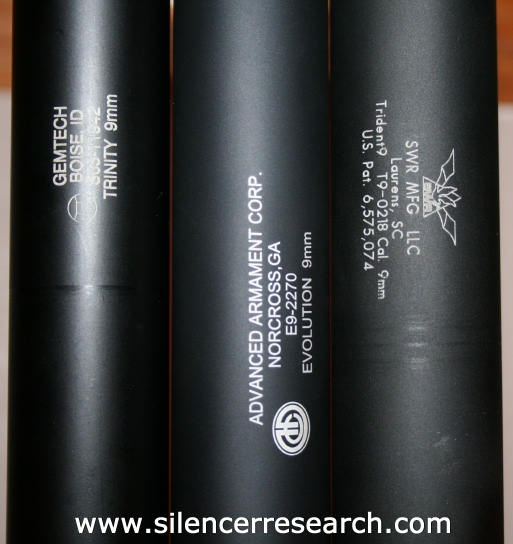
9MM SHOOTOUT and PISTOL TRIALS
On July 22, 2007 I did an extensive review of three 9mm silencers with 4 separate popular pistols. I used 3 common ammunition types. The test was to determine the sound pressure levels of each pistol and each silencer as well as to determine the optimum combination. I also tested the ballistics of each ammunition type both with and without the silencers attached.

Weapons Tested
I tested the Beretta 92FS, the Glock 17, the Sig Sauer P226 Tactical, and the H&K USP 9SD. The Beretta was fitted with a Docter Optic red dot sight. The barrel on the Beretta is the factory barrel threaded by Gemtech. The workmanship was first class, prompt, and reasonably priced. The Glock 17 was fitted with a Lone Wolf Distributors match grade drop in barrel. The barrel works well and required no extra fitting nor did it require a break in period. Raised Ameriglo night sights were also installed on the Glock because the factory sights were too low to see a proper sight picture over the silencers. The Sig P226 comes with an M13.5mmX1mm factory threaded barrel. The factory sights were replaced with Ameriglo night sights as I did on the Glock. The H&K came with a factory threaded 13.5mmX1mm as well as raised adjustable sights so I didn't have to replace the sights on the H&K.
Beretta 92FS
Watch the shootout on the Beretta
The Beretta 92FS is the official service sidearm of the United States Military. I put a Docter Optic red dot sight on this weapon, since I like red dot sights. I cannot recommend this however, since it makes it quite difficult to quickly shoot a target, as it take a few seconds to find the red dot in the tiny window. If I had it to do over, I would get regular sights that could "see" over the silencer. This Beretta was also refinished by me as my first attempt at refinishing a couple of years ago, so its not that pretty. Loaded with 15 rounds of 147 grain ammunition the Beretta with the Gemtech Trinity weighs 3 pounds 4.9 ounces. The loaded Beretta with the AAC Evolution 9 weighs 3 pounds 4.7 ounces. The loaded Beretta with the SWR Trident 9 weighs 3 pounds 6.6 ounces. The loaded suppressed Beretta weighed more than any other pistol in the trials. One of the best features of the Beretta as a suppressed pistol is that the factory barrel can be threaded, thus saving the extra expense of buying a threaded aftermarket barrel. Aftermarket barrels are expensive and don't always work flawlessly like the factory barrel does. The factory barrel comes with standard rifling. Some people report being able to use the Beretta 92FS without the need to "boost the can." I can make mine work with a reduced weight recoil spring (10lb Wolff) with both the Gemtech Trinity, however the SWR Trident 9 will not function at all without the recoil enhancer installed. I also noted no significant difference in sound pressure levels with the screw in (non-boosted) mounts as opposed to the boosted versions.
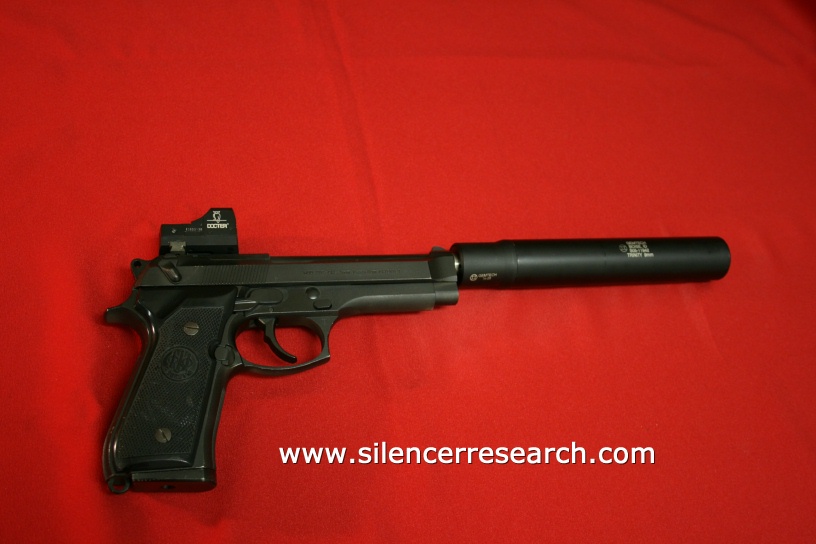
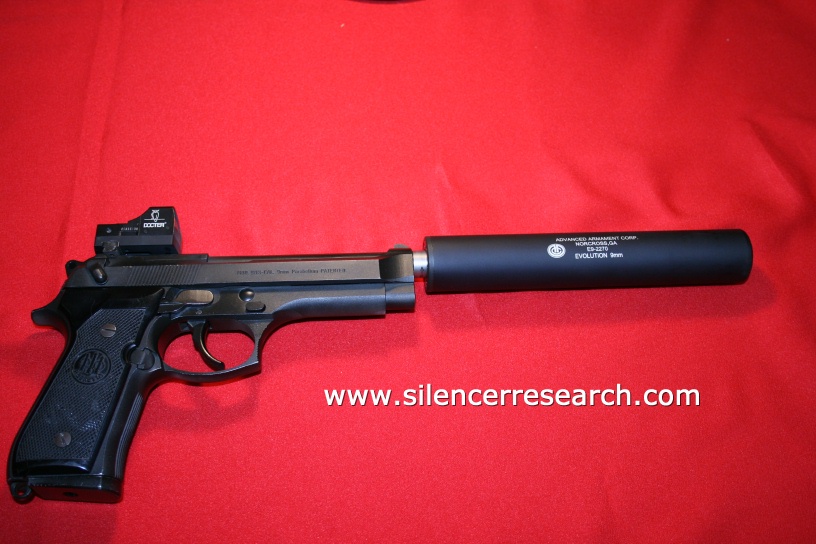

Glock 17
Watch the shootout on the Glock
The Glock 17 is one of the most favored pistols in the United States. Many law enforcement agencies choose the Glock series. I purchased a Lone Wolf Distributors threaded barrel to replace the factory barrel. The Lone Wolf barrels are not equipped with polygonal rifling as the factory Glock barrels are. In fact I don't know of an aftermarket barrel that does have polygonal rifling. I also installed raised, fixed night sights on the weapon to be able to get a sight picture over the silencers. The Glock loaded with 15 rounds of 147 grain ammunition (the magazine will hold 17) with the Gemtech Trinity weighs 2 pounds 9.9 ounces. The loaded Glock 17 with the AAC Evolution 9 weighs 2 pounds 9.7 ounces. The loaded Glock 17 with the SWR Trident 9 weighs 2 pounds 11.5 ounces. The suppressed Glock was the lightest weapon tested for the trials. The Glock 17 requires the use of a recoil enhancer at all times to function.
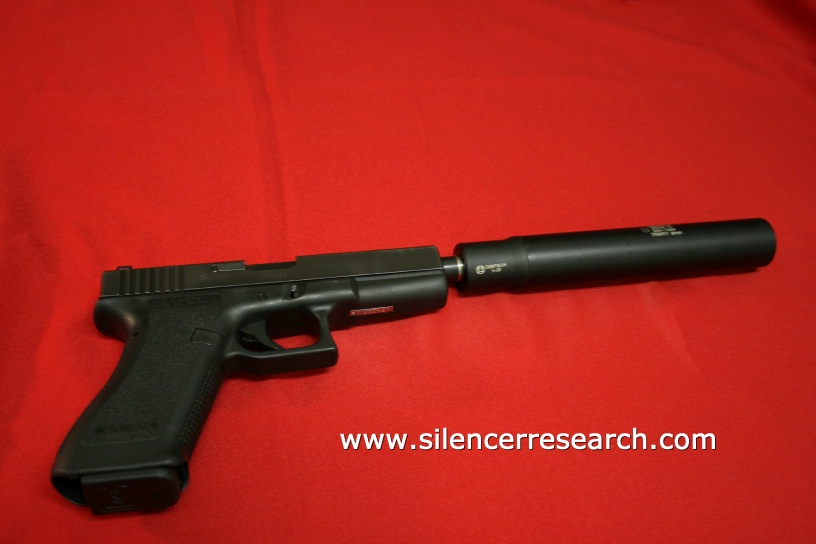

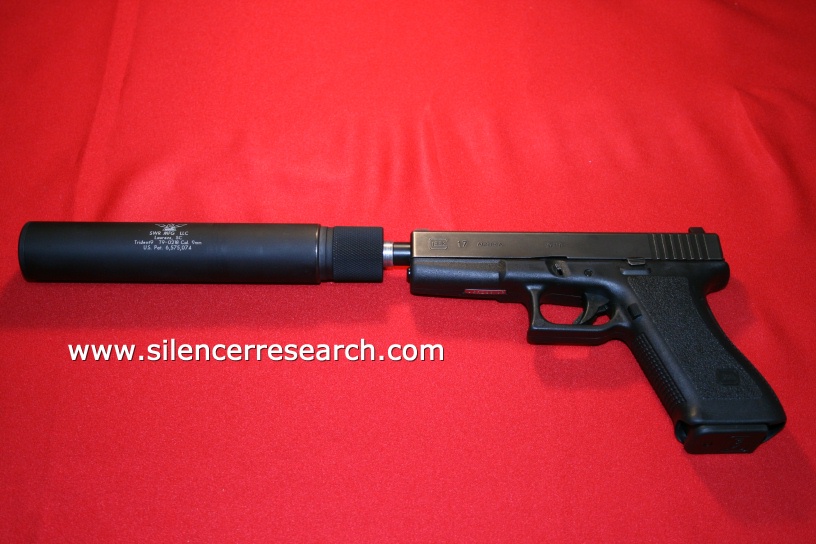
Sig P226 Tactical
Watch the shootout on the Sig P226
The Sig P226 along with the Beretta 92F were the only two pistols to successfully complete the XM9 pistol trials in the 1980's. The Sig was the low bidder for the military contract but it was awarded instead to Beretta because of Beretta's lower costs of replacement parts. The Sig a respected firearm all over the world. I installed raised night sights on the pistol to see over the silencers. The Sig P226 tactical when loaded with 15 rounds of 147 grain ammunition and equipped with the Gemtech Trinity weighs 3 pounds 1.8 ounces. The loaded Sig with the AAC Evolution 9 weighs 3 pounds 1.8 ounces. The loaded Sig with the SWR Trident 9 weighs 3 pounds 3.5 ounces. The Sig was the second heaviest pistol tested. The Sig performed well during the tests with the exception of when it was coupled with the SWR Trident 9. The factory recoil spring would not allow the reliable cycling of Special K ammo. After the tests, I replaced the factory spring with a Wolff 14 pound spring and the Sig functioned flawlessly when using Special K. The Sig P226 comes with a factory barrel that is already threaded. This saves the expense (and potentially time) involved in finding a threaded barrel. The Sig barrel has standard rifling.
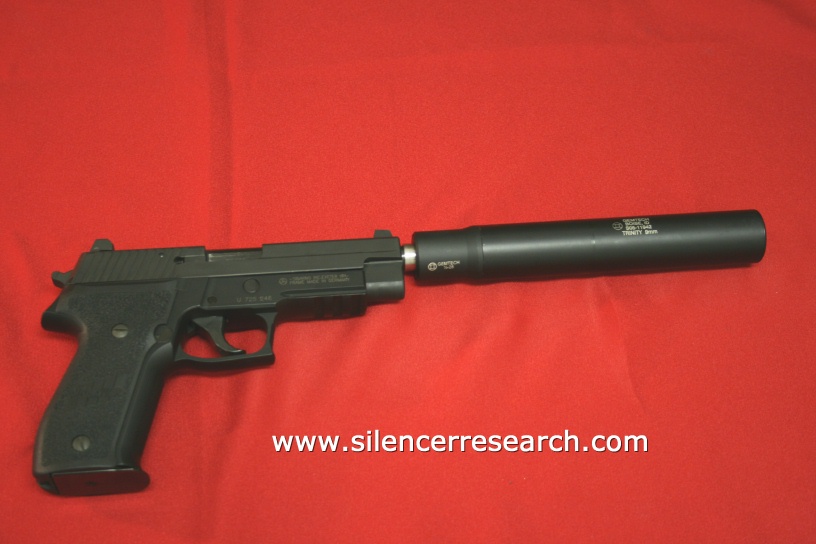


H&K USP 9SD
Watch the shootout on the H&K
The H&K USP 9SD was developed by H&K and released in 1993. The H&K USP 9SD uses a mechanical recoil reduction system that reduces felt recoil. When loaded with 15 rounds of 147 grain ammunition and equipped with the Gemtech Trinity, the weapon weighs 2 pounds 13.4 ounces. The loaded H&K wearing the AAC Evolution 9 weighs in at 2 pounds 13.1 ounces. The loaded H&K with the SWR Trident 9 weighs 2 pounds 15 ounces. It was the second lightest pistol tested. The H&K comes with factory raised, adjustable sights as well as a factory threaded barrel. The H&K comes equipped with polygonal rifling. These things makes it a fabulous choice for a suppressor host.
9MM Boosters/Neilsen Device
Each of the three silencers comes with a version of the Neilsen device. All the pistols tested were fired while the silencers were equipped with the Neilsen Device. The Gemtech version is called the L.I.D. This stands for Linear Inertia Decoupler. The AAC Evolution 9 is equipped with the A.S.A.P system which stands for the Assured Semi Automatic Performance. The SWR Trident comes with the L.C.D which stands for Linear deCoupling Device. These devices are required on a semi automatic handgun because adding the weight of a silencer to the barrel usually causes the action to fail to cycle. A Neilsen device works by temporarily relieving the weight from the barrel so it can function as if the silencer was not attached. It does so by the clever use of a spring and a piston located inside some type of housing. When the hot expanding gasses hit the booster, the spring is driven forward and "decouples" the silencer from the pistol long enough for the action to cycle. Fixed barrel pistols such as the HK P9SD and various submachine guns need no such device to function properly as the barrels on those weapons are immobile.
Watch a slow motion video
of Glock 17 with the SWR Trident 9 without a booster and then with a booster:
![]()
Gemtech's "LID" in Depth
Gemtech's Neilsen Device is called the L.I.D. The shaft in the booster is the longest of the 3 Neilsen devices and is also not ported. The L.I.D module does not act as a gas trap as is the case with the other two silencers Neilsen devices. This makes the L.I.D unique in that it does not get dirty, does not require cleaning and thus should be more reliable. This reliability comes at the cost of increased sound signature. The L.I.D can be purchased with different piston shafts to accommodate the 1/2X28TPI weapons or the M13.5X1LH threaded weapons.
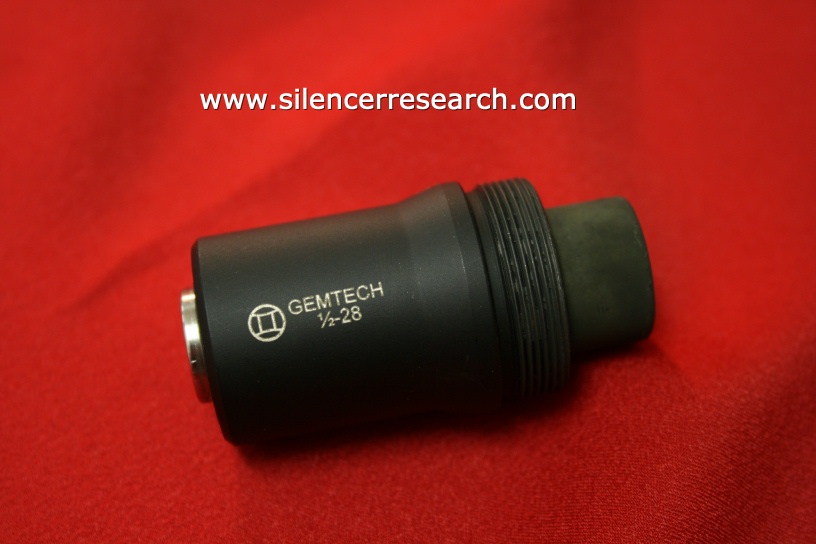
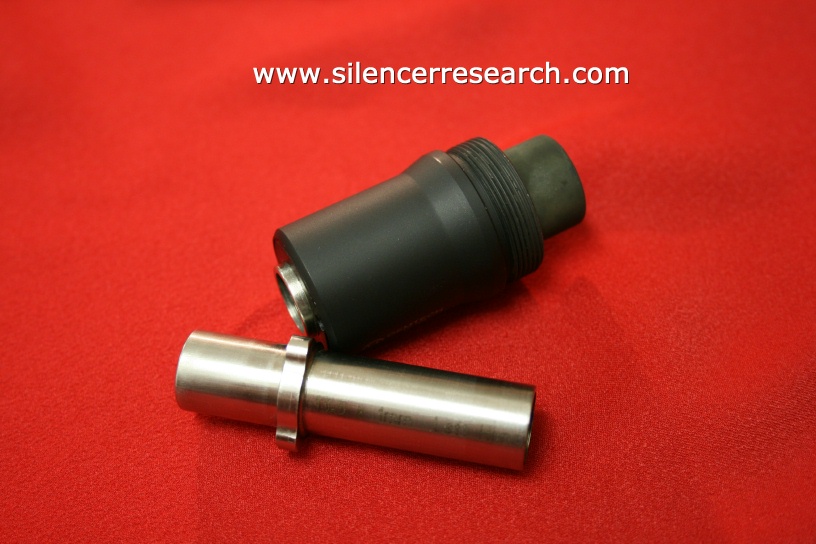
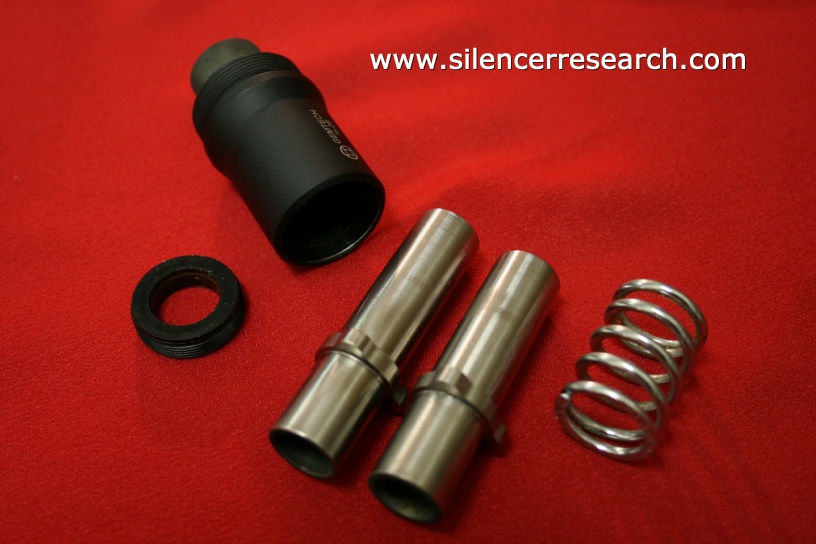
AAC Evolution 9's A.S.A.P.
The A.S.A.P. system is a completely different design than the other two pistols tested. The A.S.A.P. is actually built into the silencer body. This design allows for the booster to act as a gas trap, unlike the Gemtech design. This adds to the level of suppression, however this comes at the expense of carbon buildup inside the system. If the A.S.A.P. is not cleaned the piston will become very difficult to remove. The A.S.A.P. has it's roots in the Knight's Armament Company's (KAC) booster and the Brugger & Thomet (B&T) booster. The A.S.A.P. has one innovative feature that the KAC and the B&T don't have, and that is the ability to adjust the silencer body (for point of impact change) without removing the piston shaft. You simple hold the weapon firmly, push the silencer away from the weapon and rotate. The A.S.A.P. piston is the shortest and lightest weight of the three systems. In my opinion the A.S.A.P. is the superior design among the three silencers tested. Shafts are available in various thread pitches including 1/2X28TPI, 1/2X36TPI, and M13.5X1LH metric. Included with the silencer is a fixed barrel spacer for firing weapons that don't require a Neilsen device.

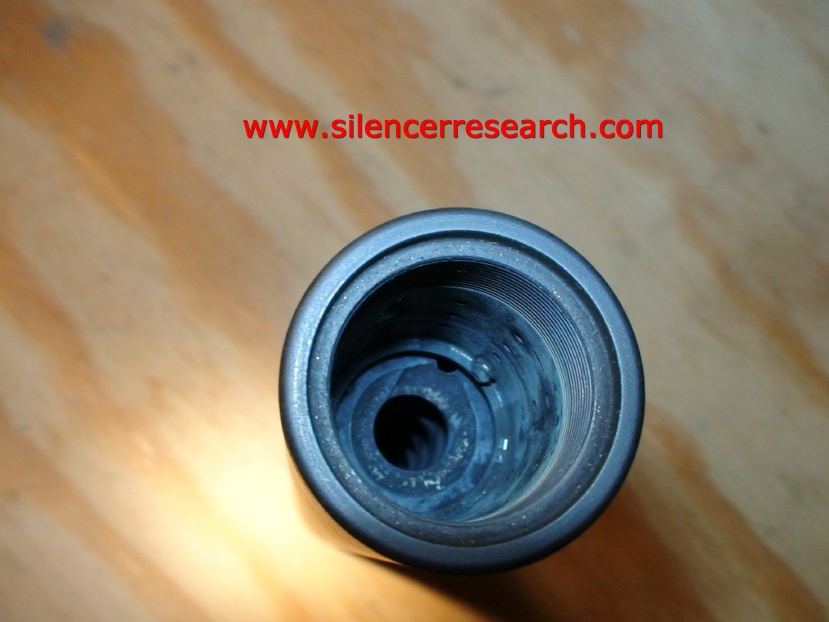
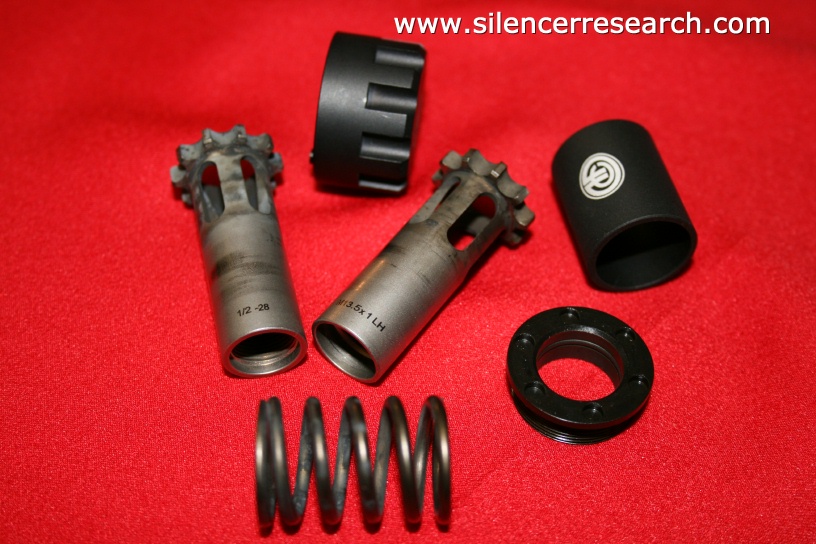
The Evolution 9 has recently undergone some minor design changes. One was the introduction of a stainless steel blast baffle. This adds to the longevity of the can as the blast baffle takes a large portion of the punishment, especially on full automatic fire from submachine guns. There was also a minor change to the piston. Longer oval, offset cuts were made instead of the older style holes. This was done to help prevent unscrewing of the ASAP cap while firing.
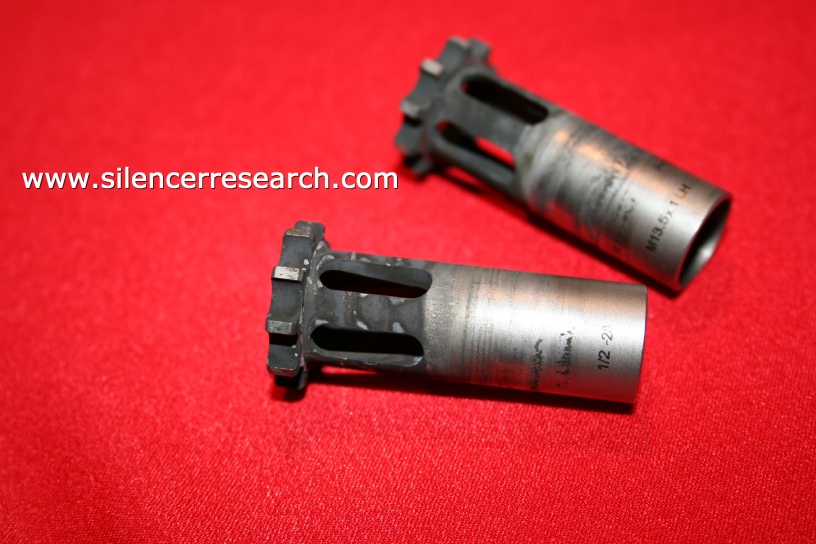
The picture below compares the old style (top piston) to the new style (bottom piston)
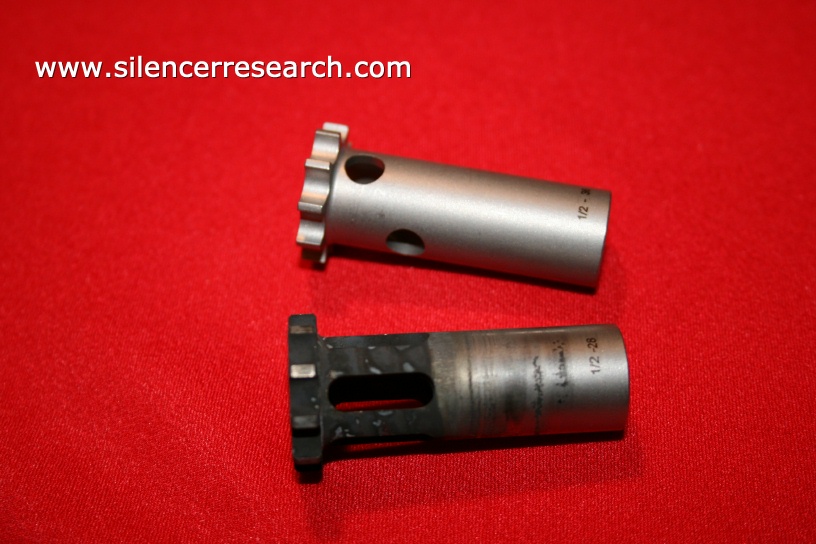
The SWR Trident 9's L.C.D.
The SWR L.C.D. is a modular booster that can be disassembled to accept different threaded shafts such as 1/2X28TPI and M13.5X1LH. The booster shafts are ported and the housing is designed to trap gases. This reduces the sound levels. However, the inside of the L.C.D housing must be cleaned since it will get dirty.
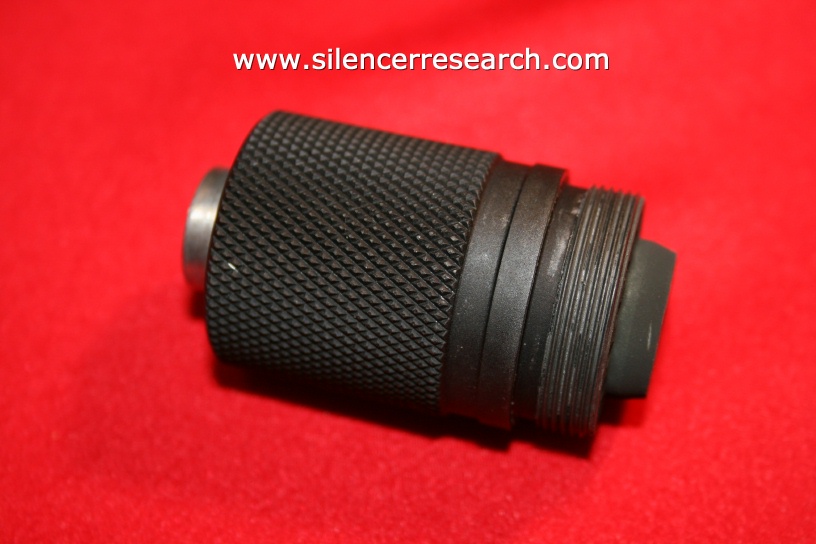
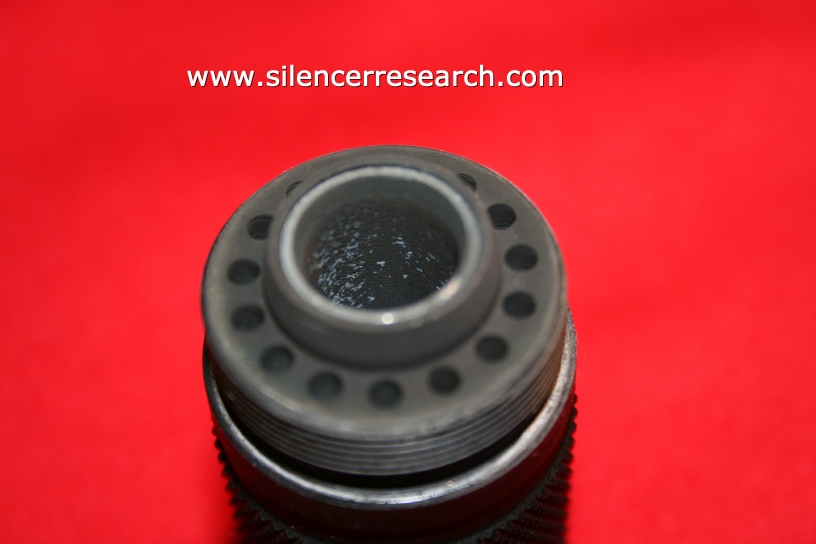
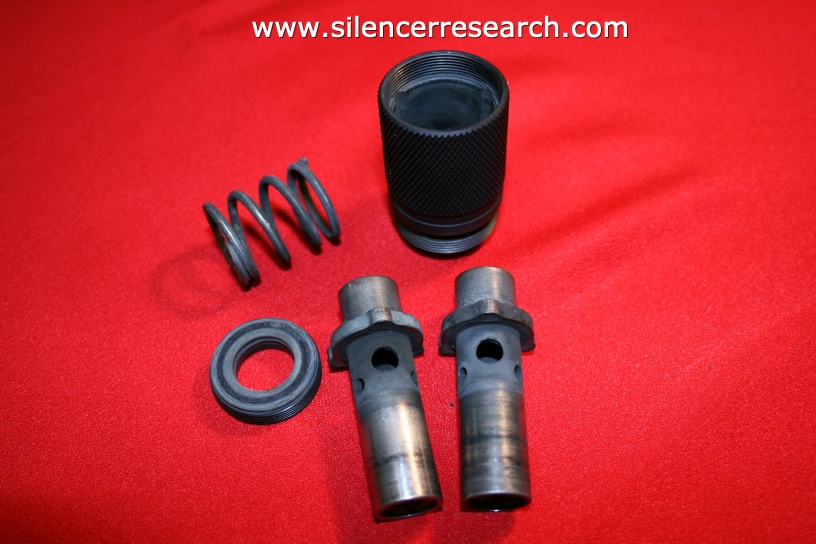

Comparing the 3 Boosters
Here is a side by side comparison of the boosters from all three silencers.
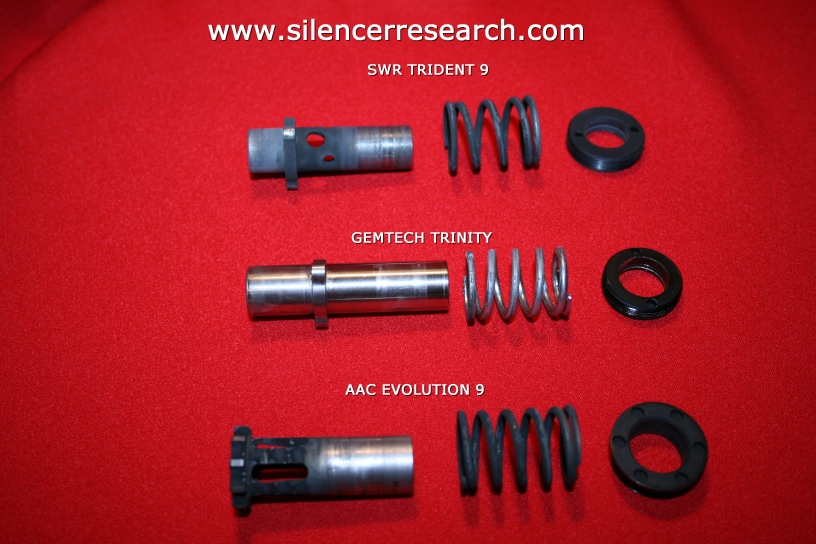
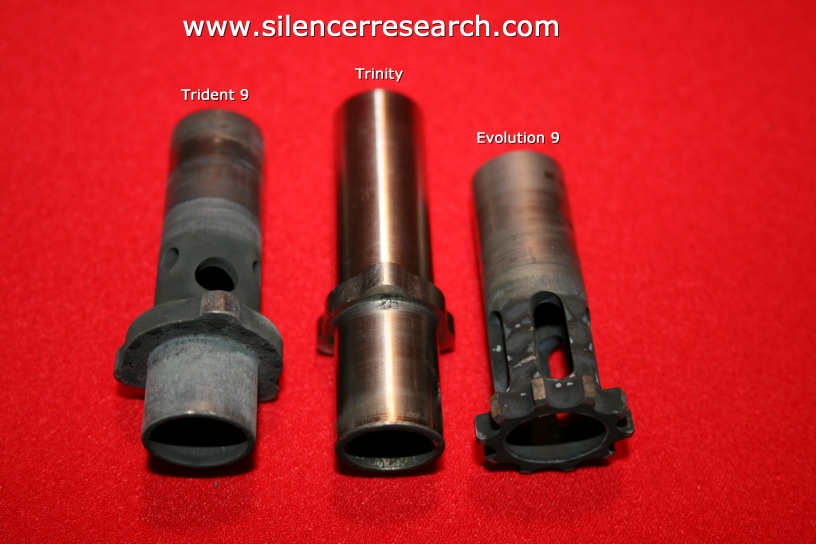
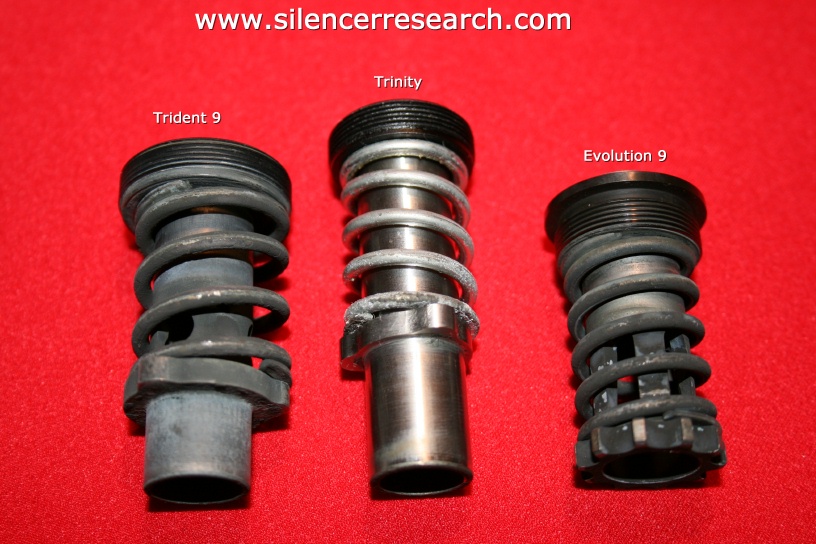
Ammunition Tested
I tested three type of common 147 grain ammo. Remington UMC Subsonic FMJ 147 grain ammo, American Eagle 147 FMJ, and Alabama Ammo 147 grain "Special K" were utilized for the tests. Each shot, both suppressed and unsuppressed were recorded with a chronograph.
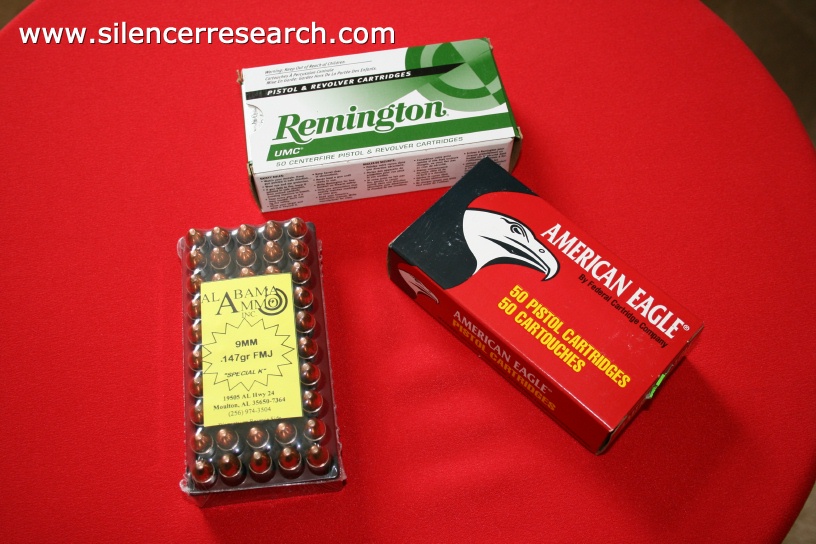
Test Results
The tests were conducted using the B&K 2209 sound meter with a B&K 4136 microphone calibrated with the B&K 4220 Pistonphone. Calibration was checked after the tests to verify there were no shifts in calibration during the tests. All equipment has been certified and tested so that it can be traced back to the N.I.S.T standards. Click HERE for the equipment certification sheets. The meter and weapon are also placed in accordance with Mil-Std 1474D protocol. I first fired 5 shots to establish the unsuppressed level and then fired 10 shots with the silencer attached with each kind of ammunition. After each test I removed the silencer and used compressed air to cool the silencer back down to ambient temperature and to remove any possibility of the previous test eliminating First Round Pop. The ammunition was at the same temperature as the outside air. The weather conditions were mostly sunny with the temperature during the entire testing period being between 83.5 and 87.3 degrees. Humidity ranged between 50% and 59% and the barometer held fairly steady between 30.18 and 30.21 inches of mercury. Elevation was 1,000 feet above sea level. The first set of charts are categorized by pistol type, showing the silencer used, then the ammo type, finished off with an average of those data. The second set of data is to compare the silencer with each ammo type regardless of what pistol was fired.
The first pistol tested was the Beretta 92FS. When firing the Gemtech Trinity I used the L.I.D instead of the 1/2X 28TPI insert as my Beretta will not function reliably without it. I can make the Beretta function with just the insert, but I have to use a 10 pound recoil spring to lighten the load the suppressor ads to the barrel. I have tested sound levels with both the L.I.D and the insert and didn't notice any significant differences in sound pressure levels. I also used the L.C.D when testing the SWR Trident and used the regular spring when I fired the EVO 9. Some people have reported the Beretta functions well with a factory recoil spring and the insert on the Trinity and the Trident. While this may be the case in some instances, it does not work reliably with my pistol. The Beretta 92FS performed flawlessly with during the tests.
| BERETTA 92FS TRINITY | dB Unsuppressed | dB Suppressed | First Round Pop | Net Reduction | Velocity Unsup. | Velocity Supp. | Free Bore Boost |
| Remington UMC 147 | 161 | 138.7 | 139.3 | 22.3 | 868 | 928.3 | 60.4 |
| American Eagle 147 | 161.6 | 139.7 | 140 | 21.9 | 898.4 | 931.2 | 34.7 |
| Special K | 159.5 | 136.4 | 138 | 23.10 | 880 | 920 | 39.9 |
| Totals | 160.7 | 138.27 | 139.1 | 22.43 | 882.13 | 926.5 | 45 |
| BERETTA 92FS EVO 9 | dB Unsuppressed | dB Suppressed | First Round Pop | Net Reduction | Velocity Unsup. | Velocity Supp. | Free Bore Boost |
| Remington UMC 147 | 161 | 134.3 | 139.7 | 26.7 | 868 | 925.60 | 57.7 |
| American Eagle 147 | 161.6 | 136 | 140.1 | 25.6 | 898.4 | 924.2 | 27.8 |
| Special K | 159.5 | 130.7 | 137.3 | 28.8 | 880 | 914 | 34 |
| Totals | 160.7 | 133.67 | 139.03 | 27.03 | 882.13 | 921.27 | 39.83 |
| Beretta 92FS SWR Trident 9 | dB Unsuppressed | dB Suppressed | First Round Pop | Net Reduction | Velocity Unsup. | Velocity Supp. | Free Bore Boost |
| Remington UMC 147 | 161 | 132 | 137.8 | 29 | 868 | 923.9 | 56 |
| American Eagle 147 | 161.6 | 133 | 140.1 | 28.6 | 898.4 | 930 | 33.6 |
| Special K | 159.5 | 126.7 | 127.9 | 32.8 | 880 | 909.3 | 29.3 |
| Totals | 160.7 | 130.57 | 135.27 | 30.13 | 882.13 | 921.07 | 39.63 |
The Glock 17 was the next pistol I tested. The Glock did jam once during the test. It jammed while firing the American Eagle 147. The jam was easily cleared and testing resumed. The use of the Neilsen device is required when using a Glock to ensure reliable functioning.
| GLOCK 17 TRINITY | dB Unsuppressed | dB Suppressed | First Round Pop | Net Reduction | Velocity Unsup. | Velocity Supp. | Free Bore Boost |
| Remington UMC 147 | 161.6 | 139.1 | 139.8 | 22.5 | 912.6 | 946.5 | 33.9 |
| American Eagle 147 | 161.6 | 140.2 | 140.4 | 21.4 | 909.9 | 936.4 | 27.5 |
| Special K | 160.1 | 136.4 | 139.7 | 23.7 | 911.4 | 941.7 | 30.4 |
| Totals | 161.1 | 138.57 | 139.97 | 22.53 | 911.3 | 941.53 | 30.60 |
| GLOCK 17 EVO 9 |
dB Unsuppressed | dB Suppressed | First Round Pop | Net Reduction | Velocity Unsup. | Velocity Supp. | Free Bore Boost |
| Remington UMC 147 | 161.6 | 132.8 | 136.8 | 28.8 | 912.6 | 933.3 | 20.8 |
| American Eagle 147 | 161.6 | 135.6 | 140.5 | 26 | 909.9 | 935 | 26.2 |
| Special K | 160.1 | 132.3 | 135.2 | 27.8 | 911.4 | 930.10 | 21.9 |
| Totals | 161.1 | 133.57 | 137.5 | 27.53 | 911.3 | 932.8 | 21.90 |
| GLOCK 17 SWR TRIDENT 9 |
dB Unsuppressed | dB Suppressed | First Round Pop | Net Reduction | Velocity Unsup. | Velocity Supp. | Free Bore Boost |
| Remington UMC 147 | 161.6 | 130.2 | 134.6 | 31.4 | 912.6 | 950.8 | 38.2 |
| American Eagle 147 | 161.6 | 132.3 | 138.4 | 29.3 | 909.9 | 947.2 | 38.3 |
| Special K | 160.1 | 125 | 125.6 | 30.10 | 911.4 | 932.8 | 21.4 |
| Totals | 161.1 | 129.17 | 132.87 | 30.27 | 911.3 | 943.6 | 32.63 |
The Sig Sauer P226 Tactical was next. The pistol comes with a factory threaded barrel in 13.5X1 Left Hand twist. The Sig performed flawlessly during the tests. The use of the Neilsen device is required when using a Sig to ensure reliable functioning.
| SIG P226T TRINITY | dB Unsuppressed | dB Suppressed | First Round Pop | Net Reduction | Velocity Unsup. | Velocity Supp. | Free Bore Boost |
| Remington UMC 147 | 161.6 | 139.8 | 140.2 | 21.8 | 898.9 | 929.1 | 30.3 |
| American Eagle 147 | 161.2 | 140.7 | 140.6 | 20.5 | 923.2 | 964.7 | 41.6 |
| Special K | 160.2 | 135.6 | 139.3 | 24.5 | 897.9 | 945.8 | 47.9 |
| Totals | 161 | 138.7 | 140.03 | 22.27 | 906.67 | 946.53 | 39.93 |
| SIG P226 T EVO 9 | dB Unsuppressed | dB Suppressed | First Round Pop | Net Reduction | Velocity Unsup. | Velocity Supp. | Free Bore Boost |
| Remington UMC 147 | 161.6 | 135 | 138.4 | 26.7 | 898.9 | 928.6 | 29.7 |
| American Eagle 147 | 161.2 | 135.8 | 140.6 | 25.4 | 923.2 | 952.6 | 29.4 |
| Special K | 160.2 | 131.2 | 137.1 | 29.0 | 897.9 | 935.2 | 37.4 |
| Totals | 161 | 134 | 138.7 | 27.03 | 906.67 | 938.8 | 32.17 |
| SIG P226
SWR TRIDENT 9 |
dB Unsuppressed | dB Suppressed | First Round Pop | Net Reduction | Velocity Unsup. | Velocity Supp. | Free Bore Boost |
| Remington UMC 147 | 161.6 | 126.3 | 129.8 | 35.30 | 898.9 | 943.78 | 44.9 |
| American Eagle 147 | 161.2 | 129.5 | 135.8 | 31.7 | 923.2 | 945 | 21.7 |
| Special K | 160.2 | 122.4 | 123.2 | 37.8 | 897.9 | 923.6 | 28.7 |
| Totals | 161 | 126.07 | 129.6 | 34.93 | 906.67 | 937.46 | 31.77 |
The H&K USP 9SD was the last pistol tested. The pistol comes with a factory threaded barrel in 13.5X1 Left Hand twist as well as raised adjustable sights. Note the increased velocities over the other guns. The polygonal rifling is increasing the velocity of all the ammunition tested. The H&K performed flawlessly during the tests.
| H&K USP 9SD TRINITY | dB Unsuppressed | dB Suppressed | First Round Pop | Net Reduction | Velocity Unsup. | Velocity Supp. | Free Bore Boost |
| Remington UMC 147 | 161.3 | 139 | 138.7 | 22.3 | 974 | 1024.8 | 50.82 |
| American Eagle 147 | 161.7 | 140.9 | 140.2 | 20.80 | 975.7 | 1009.4 | 33.7 |
| Special K | 159.9 | 136.5 | 137 | 23.4 | 971.8 | 992.5 | 20.7 |
| Totals | 160.97 | 138.8 | 138.63 | 22.17 | 973.83 | 1008.9 | 37.65 |
| H&K USP 9SD EVO 9 | dB Unsuppressed | dB Suppressed | First Round Pop | Net Reduction | Velocity Unsup. | Velocity Supp. | Free Bore Boost |
| Remington UMC 147 | 161.3 | 135.2 | 138.4 | 26.2 | 974 | 1012.6 | 38.6 |
| American Eagle 147 | 161.7 | 136.7 | 140 | 25 | 975.7 | 1000.5 | 24.9 |
| Special K | 159.9 | 131 | 135.2 | 28.8 | 971.8 | 988.5 | 16.78 |
| Totals | 160.97 | 134.3 | 137.87 | 26.67 | 973.83 | 1000.53 | 26.73 |
| H&K USP 9SD
SWR TRIDENT 9 |
dB Unsuppressed | dB Suppressed | First Round Pop | Net Reduction | Velocity Unsup. | Velocity Supp. | Free Bore Boost |
| Remington UMC 147 | 161.3 | 129.6 | 133.4 | 31.7 | 974 | 1011.4 | 37.40 |
| American Eagle 147 | 161.7 | 131.1 | 134 | 30.60 | 975.7 | 1005.8 | 30.10 |
| Special K | 159.9 | 125.8 | 125.9 | 34.10 | 971.8 | 994.4 | 22.50 |
| Totals | 160.97 | 128.83 | 131.1 | 32.13 | 973.83 | 1003.87 | 30.00 |
Remington UMC 147 Grain Ammunition
| Silencer | Unsuppressed dB | Suppressed dB | Velocity Suppressed dB | Net Reduction dB |
| Gemtech Trinity | 161.38 | 139.15 | 957.18 | 22.23 |
| AAC Evo 9 | 161.53 | 134.33 | 950.03 | 27.10 |
| SWR Trident 9 | 159.93 | 129.53 | 957.47 | 31.85 |
American Eagle 147 Grain Ammunition
| Silencer | Unsuppressed dB | Suppressed dB | Velocity Suppressed dB | Net Reduction dB |
| Gemtech Trinity | 161.38 | 140.38 | 960.43 | 21.15 |
| AAC Evo 9 | 161.53 | 136.03 | 953.08 | 25.50 |
| SWR Trident 9 | 159.93 | 131.48 | 957 | 30.05 |
Special K 147 Grain Ammunition
| Silencer | Unsuppressed dB | Suppressed dB | Velocity Suppressed dB | Net Reduction dB |
| Gemtech Trinity | 161.38 | 136.23 | 950 | 23.68 |
| AAC Evo 9 | 161.53 | 131.30 | 941.95 | 28.60 |
| SWR Trident 9 | 159.93 | 124.98 | 940.03 | 33.70 |
Summary and Conclusions
The numbers are clear and the conclusive. The SWR Trident clearly wins the pistol trials on all pistols. The quietest ammunition tested was the Special K. The worst ammunition tested was American Eagle 147 grain by Federal. The ammo is loud and it blows particles back out of the gun into your face. The quietest possible combination is the Sig P226 Tactical equipped with the Trident 9 shooting Special K. The factory recoil spring would not function the weapon in this configuration, so I replaced it with a Wolff 14 pound recoil spring. I tested the sound levels and got the same numbers, but this time the weapon functioned flawlessly. The H&K produced more velocity than the other pistols due to the polygonal rifling in the barrel. If you want the extra hitting power at the expense of the weapon being louder, than this would be my choice. If I had to pick one combination I would pick the H&K UPS 9SD with the Trident 9 shooting Remington UMC. It makes a nice tradeoff between money spent, suppression, and kinetic energy delivered to the target. The SWR Trident 9 is also larger in diameter by 1/8 inch and weighs 1.6 ounces more than either of the other two. I am impressed with the sound levels of the Trident and as of this writing it is the only 9mm silencer of the three that I would be willing to let a friend test fire DRY to see how it sounds.
The AAC Evolution 9 is a good silencer. It's A.S.A.P. system is superior to the other two Neilsen devices in my opinion. The Evo 9 while shooting Special K is very quiet. The Evolution 9 was shorter than the other two silencers and was the lightest weight by a fraction over the Gemtech Trinity.
The Gemtech Trinity is not a good dry silencer. It really needs to be wet to perform to its maximum potential. The Gemtech Trinity is a small, compact silencer and is hearing safe dry, but is no competition for the AAC Evolution 9 and isn't in the same league as the SWR Trident 9. Be sure to read the individual reviews on each silencer for more information about the silencers tested in this trial.
Copyright Silencer Research LLC. No part of this article, its videos, or numbers may be posted or used elsewhere without the prior express written consent of the author.